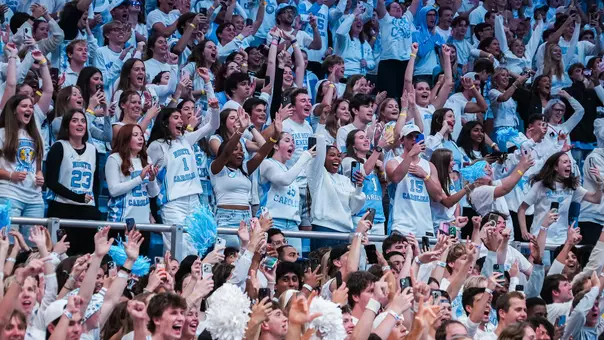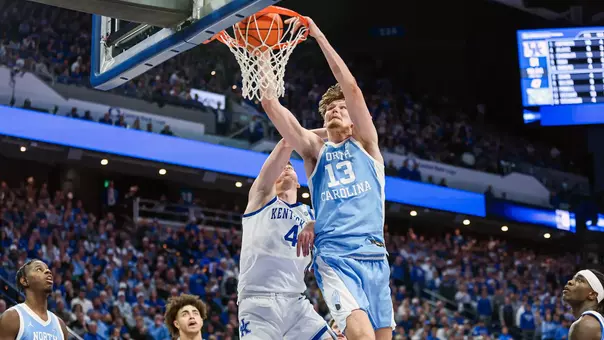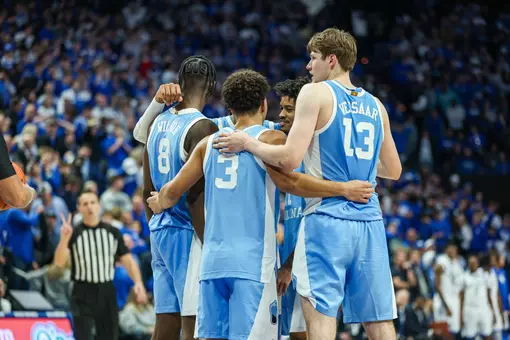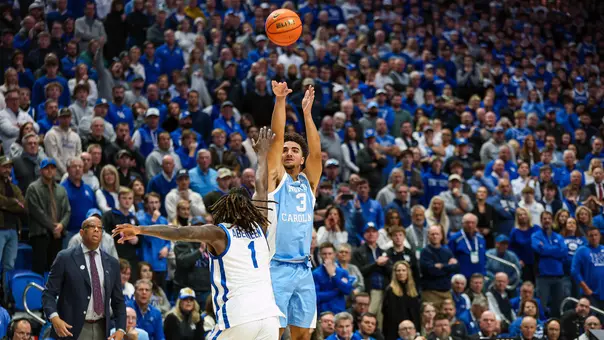University of North Carolina Athletics
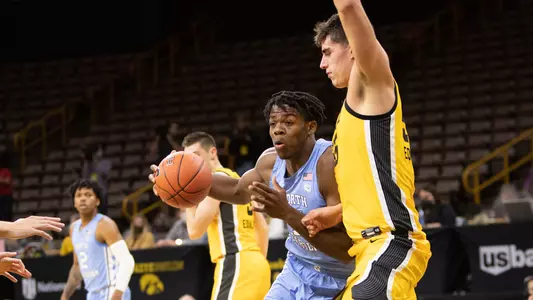
Day'Ron Sharpe
Photo by: Maggie Hobson
Lucas: Iowa Rapid Reactions
December 8, 2020 | Men's Basketball, Featured Writers, Adam Lucas
Quick takeaways from the road matchup in Iowa City.
By Adam Lucas
1. Tough night in Iowa City, as Iowa took a 93-80 win on an evening when the Hawkeyes were terrific from three-point range, making 17 three-point shots.
2. Carolina was completely and fully committed to defending National Player of the Year candidate Luka Garza in the paint. They did a credible job against Garza, rotating four big men on him to make his life difficult near the basket. But their focus on Garza allowed Iowa to rain three-point shots, as the Hawkeyes went 11-for-22 from three-point range in the first half. That was an uncharacteristic performance from the Hawkeyes, but of course every Carolina fan has seen it dozens of times before (the only missing element was that none of the Hawkeyes listed Carolina as their childhood dream school). Iowa took an incredible forty three-point shots and converted 17, which ties for the most made against Carolina in the Roy Williams era (the other was the Auburn game in the NCAA Tournament, which you probably didn't want to think about again).
3. In that first half--Carolina is now -27 in the first half in the last three games--Iowa shot better from three-point range (50 percent) than either Carolina or Iowa shot from two-point range (the Heels hit 45.8%, Iowa 30.8%).
4. Maybe it was better for the Tar Heels that Iowa spent most of the first half on the perimeter, because Carolina might not have had enough players to finish the game. When Iowa renewed their commitment to pounding it inside to Luka Garza in the second half, the Tar Heels began racking up fouls at an impressive pace. Carolina's four big men collected 10 personal fouls in the first 12:08 of the second half, leading to a situation in which Garrison Brooks, Armando Bacot and Day'Ron Sharpe all had four fouls with 7:52 to play. The absence of Sharpe, especially, who had to sit for a long stretch in the second half, was important.
5. That led to a stretch in which Garza had his most effective moments of the game. Enjoying life in the paint with Sharpe on the bench, Garza scored nine straight points for the home team. But--and this tells you the difference in the game--while Garza was operating, Carolina was cutting the deficit to just one point. If it had been a battle of big men, Carolina would have won. It wasn't, and they didn't. Carolina briefly led twice midway through the second half but Iowa scoredf 16 points on their next six trips down the court. That turned into a decisive 16-2 run.
6. Carolina has a turnover problem. The Tar Heels' trouble with the basketball helped Iowa build a big first half lead, and many of those turnovers were unforced. Carolina simply can't afford to give away that many possessions. The turnovers weren't limited to the first half. Carolina had cut the deficit to seven late in the second half and had a steal and what looked like an easy run-out, but Kerwin Walton turned it over, which led to an Iowa bucket and also started a stretch in which the Tar Heels turned it over on four out of five trips. It's tough to come back from a deficit when you aren't getting any shots. The Tar Heels ended the game with 18 turnovers. And give Iowa credit--they turned those miscues into points, scoring 23 points off turnovers.
7. Another area in which Iowa was more efficient than Carolina: second chance points. The Tar Heels won the offensive rebound battle, 15-14, but Iowa had 21 second chance points to just 14 for the Heels. Roy Williams frequently tells his team to "make them pay" after an offensive rebound. They didn't on Tuesday.
8. Helped along by Iowa's willingness to run, Carolina played at a better tempo than they did in Asheville, scoring 24 fast break points. They also handed out 22 asissts on 31 field goals.
9. Might not be any fans, but still plenty of intensity. At the 15:46 timeout in the second half, after Iowa had been called for fouling Andrew Platek, Hawkeyes head coach Fran McCaffrey stormed to midcourt to protest the call (which had been whistled on his son). As Roy Williams also argued his case during the beginning of the timeout, it turned into McCaffrey--who was doing an excellent job of protecting his chin against COVID--barking at Williams, who gave McCaffrey a thumbs-up and turned his back.
10. Speaking of that absence of fans, this might sound silly, but it's heightened the importance of the energy from the benches. It was first noticeable against Texas in Asheville, and both Carolina and Iowa very clearly had asked the reserves to provide some enthusiasm.
11. Iowa made 11 more three-point shots than the Tar Heels and won the game by 13. Doesn't take a math major to figure that one out. Another way the Tar Heels could have made some progress cutting into the deficit--free throws. Carolina hit just 12-for-20 from the charity stripe, and made only four of their final nine free throws over the final eight minutes.
12. Iowa is one of only ten programs in America that has played Carolina multiple times and has a winning record. The Tar Heels played another one of those ten the last time out, falling to Texas.
13. By now, you should be well accustomed to the Tar Heels playing some of the best teams in the Big Ten Conference in the ACC-Big Ten Challenge. Tuesday night was the third straight year the Heels have faced a top-ten squad in the event (losses the past two years to Ohio State and Michigan). Overall, it was the fifth time Carolina has faced a top-five team in the Challenge and the 11th time they have faced a top-ten opponent.
14. Iowa is one of eight Power Five schools to return at least 65 percent of its production from last season. Texas, of course, is another.
1. Tough night in Iowa City, as Iowa took a 93-80 win on an evening when the Hawkeyes were terrific from three-point range, making 17 three-point shots.
2. Carolina was completely and fully committed to defending National Player of the Year candidate Luka Garza in the paint. They did a credible job against Garza, rotating four big men on him to make his life difficult near the basket. But their focus on Garza allowed Iowa to rain three-point shots, as the Hawkeyes went 11-for-22 from three-point range in the first half. That was an uncharacteristic performance from the Hawkeyes, but of course every Carolina fan has seen it dozens of times before (the only missing element was that none of the Hawkeyes listed Carolina as their childhood dream school). Iowa took an incredible forty three-point shots and converted 17, which ties for the most made against Carolina in the Roy Williams era (the other was the Auburn game in the NCAA Tournament, which you probably didn't want to think about again).
3. In that first half--Carolina is now -27 in the first half in the last three games--Iowa shot better from three-point range (50 percent) than either Carolina or Iowa shot from two-point range (the Heels hit 45.8%, Iowa 30.8%).
4. Maybe it was better for the Tar Heels that Iowa spent most of the first half on the perimeter, because Carolina might not have had enough players to finish the game. When Iowa renewed their commitment to pounding it inside to Luka Garza in the second half, the Tar Heels began racking up fouls at an impressive pace. Carolina's four big men collected 10 personal fouls in the first 12:08 of the second half, leading to a situation in which Garrison Brooks, Armando Bacot and Day'Ron Sharpe all had four fouls with 7:52 to play. The absence of Sharpe, especially, who had to sit for a long stretch in the second half, was important.
5. That led to a stretch in which Garza had his most effective moments of the game. Enjoying life in the paint with Sharpe on the bench, Garza scored nine straight points for the home team. But--and this tells you the difference in the game--while Garza was operating, Carolina was cutting the deficit to just one point. If it had been a battle of big men, Carolina would have won. It wasn't, and they didn't. Carolina briefly led twice midway through the second half but Iowa scoredf 16 points on their next six trips down the court. That turned into a decisive 16-2 run.
6. Carolina has a turnover problem. The Tar Heels' trouble with the basketball helped Iowa build a big first half lead, and many of those turnovers were unforced. Carolina simply can't afford to give away that many possessions. The turnovers weren't limited to the first half. Carolina had cut the deficit to seven late in the second half and had a steal and what looked like an easy run-out, but Kerwin Walton turned it over, which led to an Iowa bucket and also started a stretch in which the Tar Heels turned it over on four out of five trips. It's tough to come back from a deficit when you aren't getting any shots. The Tar Heels ended the game with 18 turnovers. And give Iowa credit--they turned those miscues into points, scoring 23 points off turnovers.
7. Another area in which Iowa was more efficient than Carolina: second chance points. The Tar Heels won the offensive rebound battle, 15-14, but Iowa had 21 second chance points to just 14 for the Heels. Roy Williams frequently tells his team to "make them pay" after an offensive rebound. They didn't on Tuesday.
8. Helped along by Iowa's willingness to run, Carolina played at a better tempo than they did in Asheville, scoring 24 fast break points. They also handed out 22 asissts on 31 field goals.
9. Might not be any fans, but still plenty of intensity. At the 15:46 timeout in the second half, after Iowa had been called for fouling Andrew Platek, Hawkeyes head coach Fran McCaffrey stormed to midcourt to protest the call (which had been whistled on his son). As Roy Williams also argued his case during the beginning of the timeout, it turned into McCaffrey--who was doing an excellent job of protecting his chin against COVID--barking at Williams, who gave McCaffrey a thumbs-up and turned his back.
10. Speaking of that absence of fans, this might sound silly, but it's heightened the importance of the energy from the benches. It was first noticeable against Texas in Asheville, and both Carolina and Iowa very clearly had asked the reserves to provide some enthusiasm.
11. Iowa made 11 more three-point shots than the Tar Heels and won the game by 13. Doesn't take a math major to figure that one out. Another way the Tar Heels could have made some progress cutting into the deficit--free throws. Carolina hit just 12-for-20 from the charity stripe, and made only four of their final nine free throws over the final eight minutes.
12. Iowa is one of only ten programs in America that has played Carolina multiple times and has a winning record. The Tar Heels played another one of those ten the last time out, falling to Texas.
13. By now, you should be well accustomed to the Tar Heels playing some of the best teams in the Big Ten Conference in the ACC-Big Ten Challenge. Tuesday night was the third straight year the Heels have faced a top-ten squad in the event (losses the past two years to Ohio State and Michigan). Overall, it was the fifth time Carolina has faced a top-five team in the Challenge and the 11th time they have faced a top-ten opponent.
14. Iowa is one of eight Power Five schools to return at least 65 percent of its production from last season. Texas, of course, is another.
Players Mentioned
WBB: Post-Texas Press Conference - December 4, 2025
Friday, December 05
UNC Volleyball: Tar Heels Best UTEP in NCAA First Round
Friday, December 05
FB: #TheCall26 Signing Day Press Conference
Thursday, December 04
UNC Men's Basketball: Dixon's Clutch Play Leads Tar Heels Past Kentucky, 67-64
Wednesday, December 03











